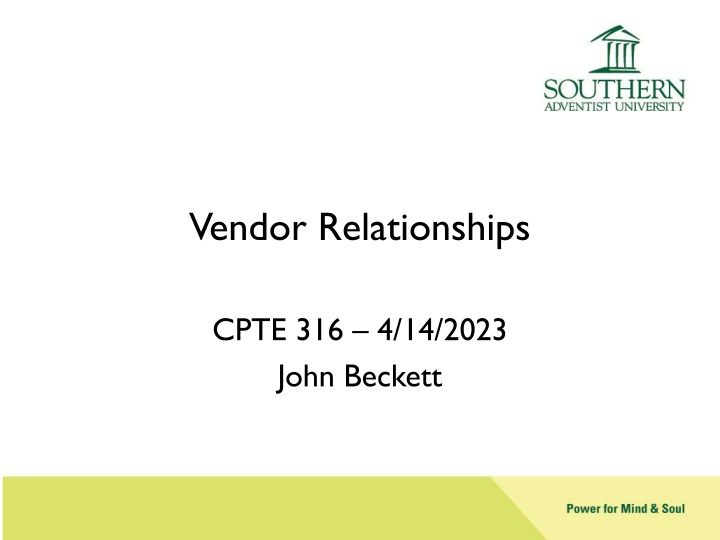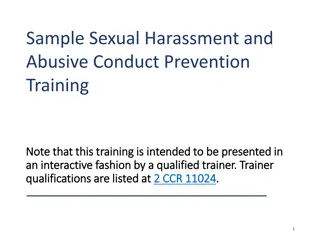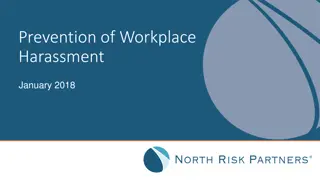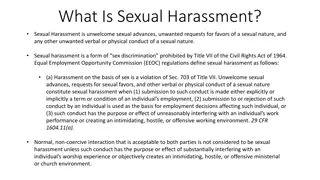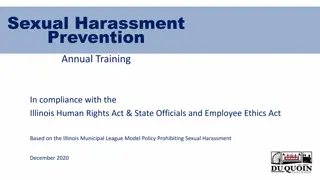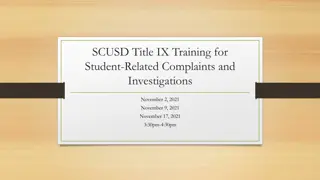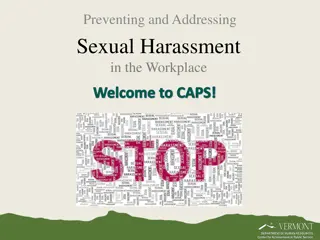Title IX Sexual Harassment Policies
In-depth coverage of Title IX sexual harassment policies and procedures including definitions, jurisdiction, reporting, investigation, hearings, and more at universities. The material details the different forms of sexual misconduct prohibited under Title IX, such as quid pro quo harassment, sexual assault, dating violence, and stalking, to ensure a safe environment for all students and staff.
Download Presentation

Please find below an Image/Link to download the presentation.
The content on the website is provided AS IS for your information and personal use only. It may not be sold, licensed, or shared on other websites without obtaining consent from the author.If you encounter any issues during the download, it is possible that the publisher has removed the file from their server.
You are allowed to download the files provided on this website for personal or commercial use, subject to the condition that they are used lawfully. All files are the property of their respective owners.
The content on the website is provided AS IS for your information and personal use only. It may not be sold, licensed, or shared on other websites without obtaining consent from the author.
E N D
Presentation Transcript
Vendor Relationships CPTE 316 4/14/2023 John Beckett
A little history from SAUs IT dept In early 1977 the total documentation for our system consumed a 1 3-ring binder We had only four vendors: Computer, terminals (2), and modems Anything else we created ourselves Database system Compilers We even built our own modems (4800 baud) because those on the market (300 baud) weren t fast enough for registration Life is very different in the 21st century!
Why Do You Need Vendors? Because you can t create everything you need yourself Being off-grid is by its nature anti-technology Because you might find a vendor is better at it than you are or they can do it for less money Because you want to focus on what makes your company or ministry special
What Do You Get From Vendors? Hardware Devices Interconnections Software Proprietary Open-Source Services Installation and/or repair Support at remote locations Connectivity
Vendor Relationship Phases Determining need Becoming acquainted Cold call Research/experience Establishing RFP Request For Proposal Vendor response Selecting vendor Contract Service Order/response Trouble handling Evaluate relationship Specific metrics Renewal
Technology Platform Everything on the previous slide Forms a basis for developing your applications Perhaps you get application software from someone else, but implement it for your own needs The platform elements do not create your success, but enable you to succeed
Technology Platform Changes Over Time Identifying and implementing new technologies Stabilizing /fixing current technologies Developing exit path for technologies that need to be deleted: Can t find good vendors There are newer or better ways to do this Control the breadth required of support people
Stage 1: Critical Vendor 1960s: You would get your entire tech platform from a single company (e.g. IBM) Your contribution was knowing how to get what was needed from that company That company might not want to cover everything, so they would work with a 3rd party to fill in gaps CalComp Plotters
Stage 2: Multiple Vendors Primary vendors for core functions Microsoft: Active Directory Networking: Cisco Hardware and software vendors might be different You need to know how to determine the core is working properly Vendor-supplied dashboards Testing tools Once the core is solid, implementing and troubleshooting other functions is easier
Major Functions / Applications Your job: Identify vendors using research Inter-operation based on standards A true standard is separate from a company or product Critical vendors have fully published their standards to establish themselves as part of the industry s technology platform De-Facto standards Based on a company s practice, not agreement
Typical Standards in IT Networking (RFP s) TCP/IP is most common Local for workstations Server WAN/Internet Directory (LDAP, X.500) Enthusiastically supported by Microsoft Email (POP, IMAP) MAPI/RPC is proprietary to Microsoft, but in August 2007 they published the specs. So although it is de facto it is supported by the vendor.
What About Proprietary Standards? Additional functionality or efficiency may come from proprietary methods Video conferencing might have higher quality if you use this brand s better protocol Requires that you use that specific brand Is this an advantage? (minus) You are locked in to that brand (plus) You are doing something better (minus) Will this work with your future platform?
Power Ratio If you are a very large customer, you can wield a lot of power over your vendors You might choose the best vendor, then manage that vendor for mutual success If you are a very small customer, your power over vendors is very limited You may be better off focusing on the local office or franchisee Your role has more to do with selecting vendors
Justin James 10 rules 6. Learn what they need from you 7. Separate people from company 8. Meet them halfway 9. Make your expectations known early 10.They are human! 1. Pay them on time 2. Learn the marketplace 3. Know their responsibilities (SLAs, etc.) 4. Don t trash talk them 5. They have other customers http://www.techrepublic.com/blog/10-things/10- things-you-can-do-to-ensure-good-vendor- relationships/
Scott Lowes Vendor Handling Techs Partner status is a treasure and tough to get Feedback is king I will never, ever share other vendor pricing Yes, cost is important, but so is service If you re a jerk in our first call, you get added to our no business list http://www.techrepublic.com/blog/tech-decision- maker/five-proven-vendor-handling-techniques/
Becketts Rules Know your contacts name, phone number May not be possible to know names in some cases Keep things on a professional level I know you can handle this No threats. If you re going to take action, simply take it Is there someone who can help me with this? Never act on negative info without confirming Do your research Contain the problem to as small an envelope as possible If nothing else works, log what is happening When processing a problem, keep the vendor updated Never believe negative information unless you have confirmed it from an alternate, reliable source
Cold Calls They want to sell you their product or service How interested are they in you needs? You might mention a project you aren t getting done They ll need to know dimensional info Give them a few moments to see if they can help Is their product/service peripheral, but you ll be stuck doing most of the work? What will you have to provide to support their product/service? Do they actually answer your questions, or defer them?
Example: 1-800-SOUTHERn Long distance vendors came in droves This was when long distance cost $$$, but fiber was driving costs down so vendors saw opportunity Some required amazing adaptation of our system or procedures to use their service My first question: Can I get 1-800-SOUTHERn? One had actually researched it She couldn t get it, but gave me the contact info to negotiate acquisition of that number Her prices on other services were competitive I signed with her company (MCI)
Very Special Deal What kind of printer do you have? HP 2607A Ooooh I have a special on that ribbon. We can divert a shipment to you at a very special price. In my mail: Note that this was now on back order Price turned out to be list Cold Calls on Friday are often from desperate people!
JIT Approach Benefits of large commitment (power ratio) Small shipments Based on specific projects Might have to buy-ahead for next year if total is short Possibly a good way to handle workstation purchases Can you get guarantee of same design?
Purchase Management - Hardware Book-keeping must be fully in operation Each device must be clearly identified Locally-built PCs: no serial number Follow-through on repair shipment Are they cross-shipping? RMA
Purchase Management - Software Careful track of all software licenses Don t allow users to install software based on a license they have purchased Central database containing licenses and keys
Shelf-ware Unfortunately, this can be a major part of your IT cost picture More common in non-profit? Hardware and software that was purchased but never installed Or perhaps became obsolete before being used Or the user didn t want to give it up Consider this a debt that must be re- purposed, returned, or charged off It can even become a storage issue
Vendor Relationships and CSA Does not require programming Does require organization People skills are an essential component In some companies, this is a pathway to higher positions
Relating to vendors by Justin James 1. Pay them on time 2. Learn the marketplace 3. Know their responsibilities, the SLAs, etc. 4. Don t trash talk them (especially in public) If you need to leave them, just leave (and leave the possibility that you might want to come back) 5. Understand that they have other customers 6. Learn what they need from you 7. Separate the people from the company 8. Meet them halfway 9. Make your expectations known early 10.Remember: They re humans too! Adapted from http://www.techrepublic.com/blog/10-things/10-things-you-can-do-to- ensure-good-vendor-relationships/
Proven Vendor-handling techs by Scott Lowe Partner status is a treasure and tough to get Feedback is king I will never, ever share other vendor pricing Yes, cost is important, but so is service If you re a jerk in your first call, you get added to our no business list Adapted from http://www.techrepublic.com/blog/tech-decision-maker/five- proven-vendor-handling-techniques/
How to Handle Cold Calls Give them five minutes to tell what their product is and how it will help you. The fact that they want to sell you something does not in itself obligate you to listen. But give them a reasonable amount of time to connect with you. Be willing to give general info Size of your company, number of workstations, mission If they do everything IT, ask for specifics If they are not interested in what you do or how you approach it, you aren t interested in them. Be willing to tell them what your current or near- future project is. For all you know, they have an approach you haven t thought of! Be very suspicious of very special deals, especially from people you don t know Often they aren t so special.
Vendor Management Governance & Performance Slideshare.net: Anand Subramaniam Adapted from http://www.slideshare.net/anandsubramaniam/vendor- management-1576246?qid=26ed1340-4502-4b23-be4d- bc2976ecd15c&v=default&b=&from_search=40
While we are free to choose our actions, we are not free to choose the consequences of our actions. - Stephen Covey
Highlights Vendor Management Strategic Partnership Vendor Governance Vendor Quality Evaluation Vendor Performance Vendor Monitor & Control
Vendor Management Vendor Profiles & Risk Assessment Performance Monitoring & Reporting Vendor Audits & Certification Vendor Manage- ment Non- conformance Corrective & Preventive Actions Product Sampling & Test Results
Vendor Management Why use a vendor? Improve cash flow Provide excellent service Improve reliability of supply Help reduce reliance on capital assets Provide cutting edge technology trends Alternate sources / manufacturing sites
Strategic Vendors Respect the environment Provide competitive pricing Provide technical assistance Identify cost saving opportunities Provide excellent customer service Engage in ethical business practices Provide quality products and services Deliver these products and services on time Continuously focus on improving processes
Vendor Profile Select the right firms Involve appropriate personnel Assess the relationship from your perspective Vendor assesses relationship independently Assessments form basis for initial conversations Focus on areas of agreement and disagreement Identify gaps Evaluate the leakage caused by these gaps Develop action plans to remedy the gaps Supplement existing metrics to evaluate progress Schedule periodic assessments
Vendor Management Strategic Areas Change & Risk Management Performance Management Purchasing Contracts Vendor Handbook Regular Meetings Vendor Audits
Vendor Handbook Main Sections Your company background Your expectations Sourcing guidelines Quality reviews Performance rating / measurement Scope Productivity improvement suggestions Escalation process Certification Procurement requirements Purchasing authorization Terms and conditions Financial information Payment terms Invoicing Delivery information contacts
Vendor Performance Rating Scope Rating criteria Quality criteria Scorecards / trends Rewards & penalty Frequency Weekly, monthly, quarterly Continuous improvement Criteria Spend Delivery Quality Service
Vendor Audits Management responsibility Purchasing Quality system Corrective control Inspection and test Control of test equipment Control of nonconforming product Handling, storage, packing & delivery
Vendor Change Management Availability changes Specification changes Manufacturing Site change Change within Supply Chain Manufacturing Process change Change to Form, Fit & Function Change to vendors raw materials
Risks Exposure using Vendors Lack of alternative vendors Inability to influence vendors Financial instability or financial failure of a vendor Ineffective management in the vendor firm Problems in electronically sharing information with vendors Vendors incorrectly interpreting requirements Natural disasters or acts of God affecting vendors operations Long physical distances between buyer and vendors Inability of vendor to meet increases in required volumes New or unproven product/process technology being used by vendors Transportation disruptions with inbound supply channels Variability in transportation times with inbound supply channels Incoming product quality problems Labor / union problems at vendors Vendors exiting market on short notice Supply disruptions in the second tier Currency rate fluctuations Material price fluctuations Pass-through Pricing (costs transferred from vendors increasing price Buyer-vendor relationships
Vendor-Risk Minimization Strategies Capacity Flexibility Delivery dependability Supply continuity plans Demand flexibility required Only one plant within vendor Single or sole sourced material Quality level and maintainability
Parnership Essentials Congruent strategies / goals Long term, not fiscal year driven Value added focus, not equipment/legacy driven Price/value relationship established Common sense of purpose Engaged governance structure Visible and active support by leaders Measurable goals set Mutual respect Sense of urgency Sharing of risks/rewards Balance in the relationship Product/quality Tactical consistency / alignment Common and mutually dependent objectives Aligned joint market/account plan with metrics Leading-edge skills transferred between functional areas Demonstrated competitive advantage Cultural compatibility Trust Open communications Information sharing passion
Example Mutually Agreed Goals Areas of Improvement Supplier qualification Supplier development Product development process Ongoing production process Quality management Planning and scheduling Systems alignment / technology integration Supplier collaboration Expected Outcome Improved part quality Reduced shortages Improved on-time delivery Lead time reduction Reduced inventory levels Reduced invoice discrepancies Reduced time to connect a new supplier Reduced transportation costs
Vendor Governance - Mission Ensure vendors are seen Contributing to cost savings Driving revenue opportunities Enhancing operational stability Improving service and performance Consistently practicing vendor management disciplines Financial management Contract administration Relationship management
Vendor Management Challenges In 2008, Gartner analysts identified the most pressing issues facing organizations Compliance (for example, SOX) Becoming a strategic customer Defining the value of vendor management Getting visibility into the portfolio of vendors Changing the culture of vendor relationships Developing a vendor management discipline Creating the right vendor performance metrics Developing the key competencies of vendor managers Allocating vendor management responsibilities to the right sources
Vendor Governances Disciplines & Tools Relationship Management Management Financial Management Contract Performance Management Disciplines Validate & manage costs Monitor the economics of the deal Ensure value proposition realized Disciplines Drive satisfaction Partnership oversight & strategic alignment Risk management Disciplines Ensure compliance with service delivery structure Resolve disputes Maintain legal documents Disciplines Ensure the right work is done right Inspect what we expect Measure and monitor delivery performance Drive operational efficiency Tools Tools Services oversight committee Semi annual customer satisfaction reviews Communication & escalation plan Annual vendor risk assesssment Tools Contract triggers Escalation map Quarterly scorecard Monthly invoice review Value proposition management Tools Weekly and monthly operational meetings/reports Vendor SLA report Quarterly business review
